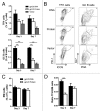The role of follicular helper T cells and the germinal center in HIV-1 gp120 DNA prime and gp120 protein boost vaccination
- PMID: 25424808
- PMCID: PMC4186047
- DOI: 10.4161/hv.28659
The role of follicular helper T cells and the germinal center in HIV-1 gp120 DNA prime and gp120 protein boost vaccination
Abstract
The importance of follicular T helper (TFH) cells and the germinal center (GC) reaction in the humoral immune response has become clear in recent years, however the role of TFH cells and the GC in an HIV vaccine strategy remains unclear. In this study, we primed mice with gp120-encoding DNA and boosted with gp120 protein, a regimen previously shown to induce high titers of high affinity and cross-reactive anti-gp120 Abs. Priming with gp120 DNA caused increased TFH cell differentiation, GC B cells, and antigen-specific antibody titers, compared with priming with gp120 protein. Priming with DNA also caused more activated CD4(+) T cells to become TFH cells and more GC B cells to become memory cells. Deletion of BCL6 midway through the vaccine regimen resulted in loss of TFH cells and GCs, and, unexpectedly, increased anti-gp120 IgG titers and avidity. Our data suggests vaccination with gp120-encoding DNA elicits a stronger and more rapid TFH and GC response than gp120 protein. Furthermore, we demonstrate that the GC reaction may actually limit antigen-specific IgG secretion in the context of repeated immunizations.
Keywords: BCL6; HIV vaccine; follicular helper T cells; germinal center; prime-boost.
Figures






References
Publication types
MeSH terms
Substances
Grants and funding
- AI082274/AI/NIAID NIH HHS/United States
- AI087191/AI/NIAID NIH HHS/United States
- AI082676/AI/NIAID NIH HHS/United States
- T32 HL007910/HL/NHLBI NIH HHS/United States
- AI065250/AI/NIAID NIH HHS/United States
- 1R21AI092212/AI/NIAID NIH HHS/United States
- 1R21AI099825/AI/NIAID NIH HHS/United States
- R33 AI087191/AI/NIAID NIH HHS/United States
- R21 AI090150/AI/NIAID NIH HHS/United States
- T32 HL007910-14/HL/NHLBI NIH HHS/United States
- U19 AI082676/AI/NIAID NIH HHS/United States
- R01 AI065250/AI/NIAID NIH HHS/United States
- 1R21AI090150/AI/NIAID NIH HHS/United States
- P01 AI082274/AI/NIAID NIH HHS/United States
- R21 AI099825/AI/NIAID NIH HHS/United States
- R21 AI087191/AI/NIAID NIH HHS/United States
LinkOut - more resources
Full Text Sources
Other Literature Sources
Research Materials
Miscellaneous
